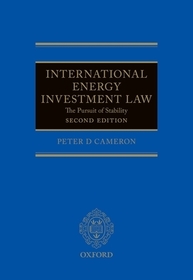
International Energy Investment Law
The Pursuit of Stability
- Publisher's listprice GBP 272.50
-
130 186 Ft (123 987 Ft + 5% VAT)
The price is estimated because at the time of ordering we do not know what conversion rates will apply to HUF / product currency when the book arrives. In case HUF is weaker, the price increases slightly, in case HUF is stronger, the price goes lower slightly.
- Discount 10% (cc. 13 019 Ft off)
- Discounted price 117 168 Ft (111 588 Ft + 5% VAT)
Subcribe now and take benefit of a favourable price.
Subscribe
130 186 Ft

Availability
Estimated delivery time: In stock at the publisher, but not at Prospero's office. Delivery time approx. 3-5 weeks.
Not in stock at Prospero.
Why don't you give exact delivery time?
Delivery time is estimated on our previous experiences. We give estimations only, because we order from outside Hungary, and the delivery time mainly depends on how quickly the publisher supplies the book. Faster or slower deliveries both happen, but we do our best to supply as quickly as possible.
Product details:
- Edition number 2
- Publisher OUP Oxford
- Date of Publication 14 October 2021
- ISBN 9780198732471
- Binding Hardback
- No. of pages864 pages
- Size 254x176x52 mm
- Weight 1619 g
- Language English 464
Categories
Short description:
This updated and expanded second edition examines how long-term energy investments are kept stable through the law of investment contracts and treaties. With increased focus on renewable energy alongside gas and oil, it provides a comprehensive review of arbitral cases and includes new and updated case studies on energy investment issues.
MoreLong description:
Following the success of International Energy Investment Law: The Pursuit of Stability, this updated and expanded second edition re-examines and assesses the variety of contract- and treaty-based instruments in commercial and international law that strive to protect the respective interests of investors and states in the international energy industry.
Over past years an unprecedented growth of international investment law in the form of BITs, MITs, other treaty-based instruments, and domestic legislation has fundamentally altered the legal framework and offers extensive scope for international arbitration in the event of disputes. A wave of unilateral state action has tested the system in a number of high-value commercial disputes, most evidently in Latin American, Eastern Europe, and sub-Saharan Africa; protection for investors is being tested as arbitrators develop new notions of legitimate expectation and give content to fair and equitable treatment, while mapping out more precisely the duties which investors owe to host states.
This book critically examines the interaction between contract and treaty forms of stability in the new multi-tier setting, including highly detailed regional case studies of Latin America, Eastern Europe, and (new to this edition) Africa. Central to the new edition is its expanded content on renewable energy, including claims under the Energy Charter Treaty, and energy-related minerals now playing a key role in the transition to a low carbon economy; the updated chapter on environmental issues also addresses decommissioning and low carbon/climate change issues.
The book also considers emerging issues in unconventional oil and gas, issues arising from energy network operation including transit, and damages issues arising in energy cases. Particular attention is paid to the practical impact of these issues and the enforcement of awards by arbitration tribunals and bodies such as the ICSID, the ICC, and the LCIA. In its concluding section, the book looks forward to new challenges arising from climate change, human rights, and environmental issues.
Review from previous edition Professor Cameron carefully paints on a large canvas. The results will be of high interest to the student and practitioner of international energy law.
Table of Contents:
Part I
1: Energy Investment Law
2: States, Investors, and Energy Agreements
3: Stability based on Contract
4: The Classic Tests of Contract-based Stability
5: Stability based on Treaty
Part II
6: Meeting Challenges to Investment Stability - across the Energy Spectrum
7: Latin America: Treaty and Contract Stability in the Face of Policy Alignment and Crisis
8: Russia, Ukraine, and Central Asia: Treaty and Contract Stability in the Post-Soviet Space
9: Africa: Treaty and Contract Stability
Part III
10: The Limits to Investment Stability: Environmental, and Human Rights Issues
11: Damages and Enforcement of Awards
12: Guarantees for Long-Term Energy Investments: Expectations and Realities




